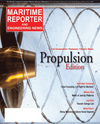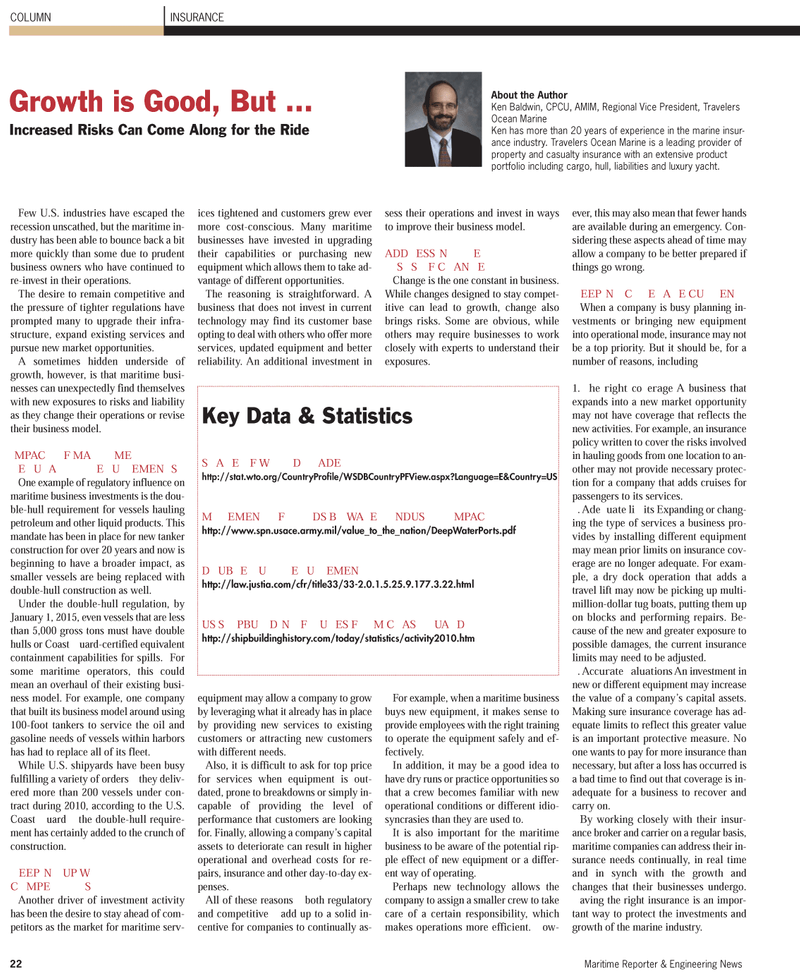
Page 22: of Maritime Reporter Magazine (September 2011)
Marine Propulsion Annual
Read this page in Pdf, Flash or Html5 edition of September 2011 Maritime Reporter Magazine
INSURANCECOLUMNGrowth is Good, But ... Increased Risks Can Come Along for the Ride Few U.S. industries have escaped the recession unscathed, but the maritime in- dustry has been able to bounce back a bitmore quickly than some due to prudentbusiness owners who have continued to re-invest in their operations. The desire to remain competitive and the pressure of tighter regulations have prompted many to upgrade their infra- structure, expand existing services and pursue new market opportunities. A sometimes hidden underside ofgrowth, however, is that maritime busi- nesses can unexpectedly find themselves with new exposures to risks and liability as they change their operations or revise their business model. MPAC F MAME EUA EUEMENS One example of regulatory influence on maritime business investments is the dou- ble-hull requirement for vessels hauling petroleum and other liquid products. This mandate has been in place for new tanker construction for over 20 years and now is beginning to have a broader impact, as smaller vessels are being replaced with double-hull construction as well. Under the double-hull regulation, by January 1, 2015, even vessels that are less than 5,000 gross tons must have double hulls or Coast uard-certified equivalent containment capabilities for spills. For some maritime operators, this couldmean an overhaul of their existing busi- ness model. For example, one company that built its business model around using 100-foot tankers to service the oil and gasoline needs of vessels within harbors has had to replace all of its fleet.While U.S. shipyards have been busy fulfilling a variety of orders they deliv- ered more than 200 vessels under con- tract during 2010, according to the U.S.Coast uard the double-hull require- ment has certainly added to the crunch ofconstruction.EEPN UP W CMPES Another driver of investment activity has been the desire to stay ahead of com-petitors as the market for maritime serv- ices tightened and customers grew ever more cost-conscious. Many maritime businesses have invested in upgrading their capabilities or purchasing new equipment which allows them to take ad- vantage of different opportunities. The reasoning is straightforward. A business that does not invest in current technology may find its customer base opting to deal with others who offer more services, updated equipment and betterreliability. An additional investment in equipment may allow a company to grow by leveraging what it already has in place by providing new services to existing customers or attracting new customers with different needs. Also, it is difficult to ask for top price for services when equipment is out-dated, prone to breakdowns or simply in- capable of providing the level of performance that customers are lookingfor. Finally, allowing a company?s capital assets to deteriorate can result in higheroperational and overhead costs for re- pairs, insurance and other day-to-day ex- penses.All of these reasons both regulatory and competitive add up to a solid in- centive for companies to continually as- sess their operations and invest in ways to improve their business model. ADDESSN E SS F CANE Change is the one constant in business. While changes designed to stay compet-itive can lead to growth, change also brings risks. Some are obvious, while others may require businesses to work closely with experts to understand their exposures. For example, when a maritime business buys new equipment, it makes sense to provide employees with the right training to operate the equipment safely and ef-fectively. In addition, it may be a good idea tohave dry runs or practice opportunities so that a crew becomes familiar with new operational conditions or different idio- syncrasies than they are used to. It is also important for the maritimebusiness to be aware of the potential rip- ple effect of new equipment or a differ- ent way of operating. Perhaps new technology allows the company to assign a smaller crew to take care of a certain responsibility, which makes operations more efficient. ow- ever, this may also mean that fewer hands are available during an emergency. Con- sidering these aspects ahead of time mayallow a company to be better prepared if things go wrong.EEPN CEAE CUEN When a company is busy planning in- vestments or bringing new equipment into operational mode, insurance may notbe a top priority. But it should be, for a number of reasons, including1.he right coerage A business that expands into a new market opportunity may not have coverage that reflects the new activities. For example, an insurance policy written to cover the risks involved in hauling goods from one location to an-other may not provide necessary protec- tion for a company that adds cruises for passengers to its services..Adeuate liits Expanding or chang-ing the type of services a business pro- vides by installing different equipment may mean prior limits on insurance cov- erage are no longer adequate. For exam- ple, a dry dock operation that adds atravel lift may now be picking up multi- million-dollar tug boats, putting them upon blocks and performing repairs. Be-cause of the new and greater exposure to possible damages, the current insurancelimits may need to be adjusted..Accurate aluations An investment in new or different equipment may increase the value of a company?s capital assets. Making sure insurance coverage has ad- equate limits to reflect this greater value is an important protective measure. No one wants to pay for more insurance than necessary, but after a loss has occurred is a bad time to find out that coverage is in- adequate for a business to recover and carry on.By working closely with their insur- ance broker and carrier on a regular basis, maritime companies can address their in-surance needs continually, in real time and in synch with the growth and changes that their businesses undergo. aving the right insurance is an impor- tant way to protect the investments and growth of the marine industry. About the AuthorKen Baldwin, CPCU, AMIM, Regional Vice President, Travelers Ocean Marine Ken has more than 20 years of experience in the marine insur- ance industry. Travelers Ocean Marine is a leading provider of property and casualty insurance with an extensive product portfolio including cargo, hull, liabilities and luxury yacht. 22Maritime Reporter & Engineering News Key Data & StatisticsSAE F WD ADE http://stat.wto.org/CountryProfile/WSDBCountryPFView.aspx?Language=E&Country=US MEMEN F DS B WAE NDUS MPAC http://www.spn.usace.army.mil/value_to_the_nation/DeepWaterPorts.pdf DUBE U EUEMEN http://law.justia.com/cfr/title33/33-2.0.1.5.25.9.177.3.22.html US SPBUDN FUES FM CAS UAD http://shipbuildinghistory.com/today/statistics/activity2010.htm

 21
21

 23
23
